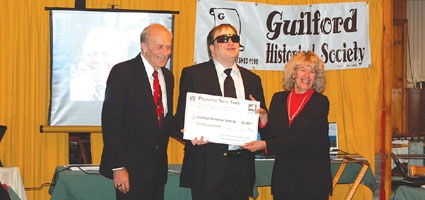Guilford historical society receives Preserve New York grant
MT. UPTON – The Guilford hamlet of Rockwell’s Mills is a step closer to being added to the National Register of Historic Places thanks to the continued hard work and dedication of Town of Guilford Historian Thomas Gray and the Guilford Historical Society.
Last week, the volunteer-driven organization was presented with two checks totaling the remaining amount needed to complete the historic district nomination process.
“Our society believes that nothing remains unless someone preserves it,” said Gray, at the organization’s annual dinner, held on Oct. 8 at the Old Mill Restaurant in Rockwell’s Mills.
During the function, Gray joined GHS President Scott Parsons in accepting both a $600 check from Deputy Supervisor Bruce Winsor on behalf of the Guilford Town Board and a ceremonial check signifying the $2,000 Preserve NY Grant the society has been awarded through a program made possible through a cooperation of the New York Preservation League and the New York State Council of the Arts.
The Old Mill was an appropriate venue for the presentation, according to the historian, because the stone structure which houses the restaurant is all that remains of the original mill constructed on the banks of the Unadilla River in 1791. Up until 1841, it served as first a grist mill and then a cotton mill, before being acquired by Chester Rockwell, who converted the structure into a woolen mill and gave his name to both it and the surrounding community.








Comments